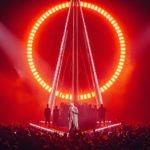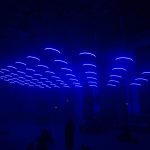Daniil Simkin’s Falls the Shadow at the Guggenheim Museum Fuses Projection and Dance
For Falls The Shadow, a dance piece created for the Guggenheim Museum’s Works & Process series and staged in the famed art repository itself, choreographer Alejandro Cerrudo and principal dancer/director Daniil Simkin teamed up with projection designer Dmitrij Simkin and costume designer Dior for an unusual convergence of fashion, technology and art. Four dancers had their movements captured by motion sensors, which generated 3D mapped visuals that were then projected back onto the floors and the ramp of the famed building.
Four 30-minute performances took place on Sept. 4-5, with standing audience members observing the show from different levels of the venue, which is known for its continuous ramp that spirals up the rotunda structure and connects to all of the floors

Melded Artistry
The dancers performed separately and together, the movements of their bodies integrated with groups of projected “particles” flowing around them. Their choreography instigated video movement on the floor and up the sides of the ramps from the projectors. Sometimes the effect was black particles on the white floor, and sometimes that basic color scheme was reversed. At times, the ramps “shimmered” upwards from the projections.
This merger of performance and technology naturally raises the question: Which came first, the choreography or the projections? Daniil says both. Even though the choreography was originally manifested in the studio, both aspects were being adjusted as the team prepared for the four shows at New York’s Guggenheim.
“It’s tricky, because the choreography is being viewed from above, and thematically there are adjustments,” explains Daniil. “The perception from above is very difficult to imagine for a choreographer, and the projection is also difficult to imagine. We showed a lot of the possibilities to the choreographer from our technical team,” which consisted of his father Dmitrij and Berlin-based interactive designer Arístides García. “The four of us basically made the artistic decisions. It’s not what came first — it all happened simultaneously.”
In his position as both dancer and director, Daniil did not alter the choreography, but he says that Cerrudo was open to ideas. “He wanted his choreography to be very natural, therefore he was very open to collaboration as well,” says Daniil. The other dancers included Cassandra Trenary, Ana Lopez and Brett Conway.
An Emotional Journey
Part of the T.S. Eliot poem, “The Hollow Man,” was used as an aesthetic point of departure for Falls The Shadow, which Daniil views as an emotional journey. “It’s a journey of these four individuals on stage, and the goal of the performance was to create a piece of art which stands on its own and is bigger than the sum of its parts,” he says, adding that the artists wanted their work to move the audience in a way that nothing else had before. “A lot of the performance had a ceremonial feel just because of the nature of it.”
Daniil says that entering the Guggenheim itself is almost like going into a church because of the feeling it inspires within him, and that sentiment also influenced the production. The audience came in and the mood was already set by ambient music playing before the performances started. “In general, something was already happening even though nothing was [yet] happening, dancing wise,” he says. “This was the gist of the whole thing.”
Each of the four performances of Falls the Shadow varied since the dancers’ movements, and hence the way the projections reacted to them, were slightly different. Further, audience members perceived the show differently depending upon which floor (from the second to the fifth) that they were watching the performance from. Watching it from high above offered a wider vantage point than if one witnessed it from the second floor.
Through the dance between performers and the “particles” projected on the floor, the artists sought to create something with meaning but without an overt story. “Each particular particle [can be] seen as a bit more frantic and more chaotic,” notes Daniil. “It’s less structured, and each person can decide what it means for them. You could say that we are four people in the cosmos or in this maelstrom or whatever. It’s for each audience member to decide for themselves. Because it’s happening in real time, it’s fascinating to see what is possible these days and how we can create something integral with integrity in itself as a piece of art.”

Not Just Immersive — Disorienting
For the dancers, the projections created a sense of motion that threw them off-kilter, as it looked like the floor was moving underneath them. Daniil notes that it was very disorienting and required more balancing for turning. “You have to focus on a point which is not projected on, like somewhere on the side, in order not to get dizzy or lose your balance,” he explains. “The closer you are to the projector, the more disorienting it is.”
His father, projection designer Dmitrij Simkin, tells PLSN that that this was not his first time working with interactive projection design. He previously applied the technology to a few short dance pieces and partially in larger-scale projects. He makes the distinction that with interactive design, one does not design video clips but mostly programs the data flow. “Cameras capture the dancer movements, deliver this data to the system, and at the end of a long chain of computer algorithms, we output some real-time images,” explains Dmitrij.
The designer says that there are a few specific challenges in using interactive video projections for a dance production. First, one should be careful in balancing the choreography and the visuals. “Together with the choreographer, we are sharing the same channel of visual communication,” says Dmitrij. “On top of that, our visual outputs happen on the same spot and in the same time. It’s absolutely necessary. If I project interactive video on a 50-foot remote wall or with a 5-minute delay, no one will be able to link together the dancers’ input and my output.”

A Balancing Act
Because the projection visuals were triggered by the dancer movements, the former took on a supporting role that Dmitrij notes could be easy to draw attention to. But the balancing act “is very delicate,” he says. “At the end, it looks like you ‘dress’ the dancers’ movements. This dress is very dynamic and can have many colors and shapes. Our task was not to make this a fashion event, but to make the audience still see the dancer and his choreography behind this dress.”
In comparing this production with other video-related ones, Dmitrij says that there were many limitations. He says that the 3D computer graphics are “actually fake 3D in our two-dimensional projection world. No matter how well you do it, you cannot make it ‘believable’ for an audience if they [get so] close that they see the real dancer.” The task was always to align the dancer choreography with visual content. “The major goal [was] to get one unit,” he says. “No border between. Sometimes one compares it with stage lighting. But interactive video is more present and more closely related to dancer movement than stage lighting. I would say that if the lighting designer ‘lights’ the choreography, the interactive designer is choreographing the light.”
For Falls the Shadow, one projector was used for the floor surface, which was a white dance marley with a circular shape and a diameter of 41 feet and four for the rotunda parapet mapping. Given the limitations and circumstances for working in a museum that has steady foot traffic every day, Dmitrij and his collaborators needed a very portable and quick installation setup that they could strike after every rehearsal or performance day. The projectors selected were Christie M Series 14K with wide-angle lenses. The designer likes that they have the smallest chassis in their class for portability.
Although the ramp of the Guggenheim spirals up, Dmitrij says there was no added difficulty in mapping onto its different levels. He says an important idea was to integrate the iconic spiral shape into the dance piece being performed on the ground floor. “The interactive visuals generated by the dancers on the floor level spread out and expanded on the rotunda levels and acted as a bridge between,” he remarks.
García was responsible for the system design and generating many parts of the show. “We worked together for the first time and shared our know-how with each other,” says Dmitrij, who normally works in theater-like environments as a set designer (and in most cases he integrates video into his work). “It was a new experience to work in a museum with special rules and regulations, but I was very pleased to meet the Guggenheim tech crew. It was definitely not easy for them to work [until] midnight, and I understand that setting up 360-degree mapping, infrared lighting and many other things are not their daily tasks. But they all were engaged and enthusiastic to make something special. I think we can be happy with the results.”
Dmitrij believes audiences were satisfied with this dance experience, and he does not believe that many of those in attendance had seen the combination of a dance piece with interactive video projection and architectural mapping. He notes that with such technology it would be easy to create a visual effects extravaganza with that “cool techno touch,” but the collaborators sought to “make something artistic, poetic and refined,” he says. “My biggest ambition in using interactive projections is that people forget the technology behind it and stop asking, ‘How does it work?’ And finally start seeing some art.”
One Projector to Four
For Daniil, the most challenging aspect of working with the projections was simply wrapping his head around using them. For a long period of time, the dancers were only working with one projector, so it was harder to gauge the impact of how the show would come off with four projectors on the ramps and one on the floor. “It’s one thing to imagine all of this in theory and see renderings, and another to actually be in the space and see what works and what doesn’t,” he says. “It’s like heavily renovating an apartment. You can only visualize so much, and once you do it, it’s actually different.”
Having previously staged a show at the Joyce Theater in Manhattan using projections on the floor, Daniil feels that performing at the Guggenheim was a natural evolution with the technology. “It’s the next step, using a very special building and it’s iconic architecture [as] an active player in the piece,” he says. “It is the [ideal] place such a performance can take place because it’s white, it’s very symmetrical, and it has a special aura in itself already. Using this and the video projections to link between the dance, the projections, and the architecture is an opportunity we couldn’t miss. To me, this was the best possible site to create this with video projections.”


